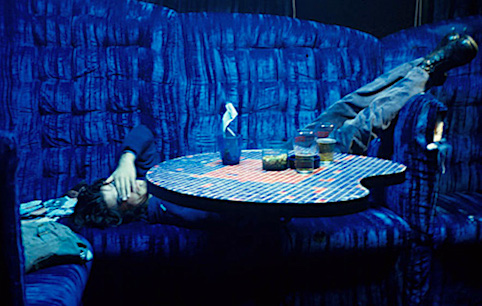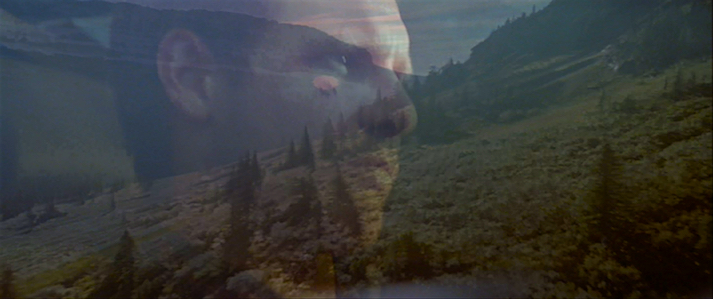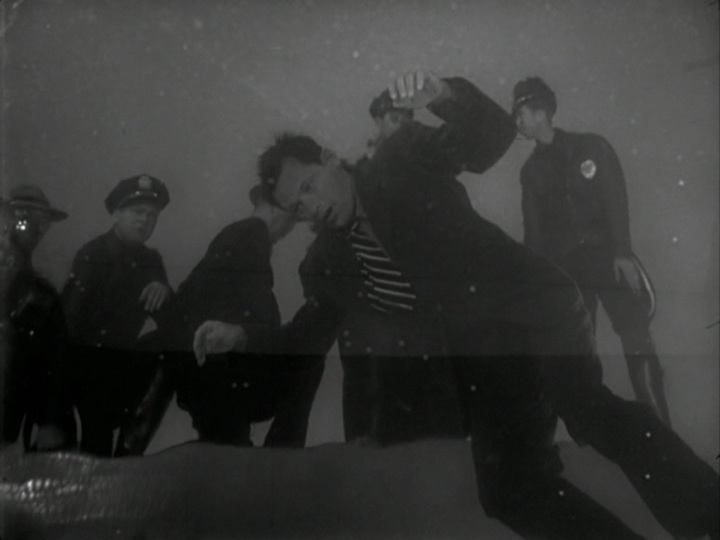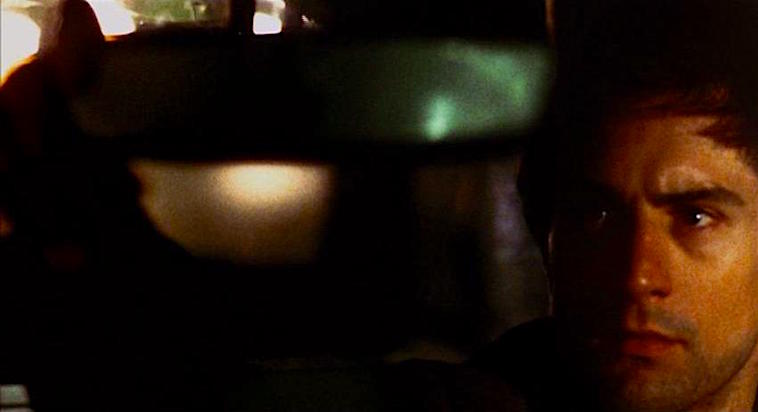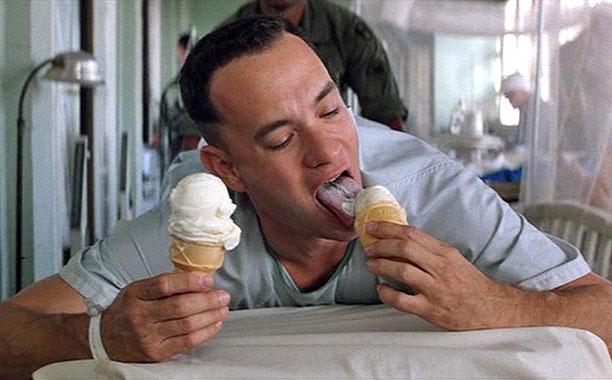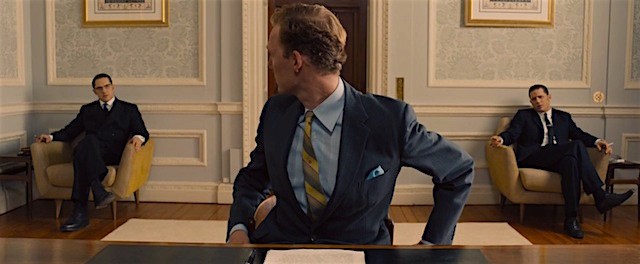He might not be the first name that pops into the minds of cinephiles, but Christopher Doyle is one of the most important cinematographers working. When he is behind the camera, the film’s world suddenly envelops us in unique perspectives blending color, movement and shadows together in such a way that even the ugliest corners of the world are transformed into a sort of rapturous beauty. At the same time, he has the gift of bringing his vision into focus with that of his director. I find it almost impossible to describe the ways in which Doyle can take dilapidated walls, cracks, rusted objects, smoke or even human brutality and create a visionary sort of rainbow.

Maggie Cheung and Tony Chiu Wai Leung in the shadows of perspective.
In the Mood for Love
Kar-wai Wong, 2000
Cinematography | Christopher Doyle
I often find myself wanting to reach through the screen and touch the objects that catch his camera’s eye. It is the fact that I always have an immediate response to not move my arms or hands. Very often what Christopher Doyle films are objects that ordinarily I would have no interest in touching. The images project a sort of beauty, but they are never denied reality.

Tadanobu Asano’s good looks can’t pull our eyes away from where he stands. This stance is both literal and metaphorical.
Invisible Waves
Pen-Ek Ratanaruang, 2006
Cinematography | Christopher Doyle
Christopher Doyle’s work with Pen-Ek Ratanaruang remains as fresh and oddly sensual as when their collaborations were first released. Dark stories of lost and damaged people trying to find their way to better places. Doyle’s camera forms as much of these stories as do Ratanaruang and his casts.

A lizard slithers up the wall behind Kenji’s library…
Last Life in the Universe
Pen-Ek Ratanaruang , 2003
Cinematography | Christopher Doyle
Pen-Ek Ratanaruang’s Last Life in the Universe follows the story of a lonely man who only begins to find a bit of hope after a criminal arrives to his apartment. This hope is found in the form of another’s tragic death. The grief stricken begins to bond with Kenji, an intelligent outsider who has lost all hope.

Even the unwanted arrival of a criminal fails to fill Kenji’s world. He is alone and lonely.
Last Life in the Universe
Pen-Ek Ratanaruang, 2003
Cinematography | Christopher Doyle
Doyle’s camera captures this story from a number of perspectives and frames filled with colors, shadows and meanings.

Could this really be happening? A beautiful young woman allows Kenji into her home and falls asleep within his grasp. The perspective indicates a distance, but retains a sense of warmth and possibility.
Tadanobu Asano and Sinitta Boonyasak
Last Life In The Universe
Pen-Ek Ratanaruang, 2003
Cinematography | Christopher Doyle
Last Life in the Universe is a quirky, darkly comical and often disturbing Thai film that is as realistic as it is absurd and surreal. A criminal enters the void of Kenji’s solitary life in Bangkok and a series of disturbing events leads him to enter the life of a female polar opposite to himself. Distorted and contradictory in image as it is in story, Ratanaruang’s film is a surprisingly emotional love story.

A change in perspective and a later shift of natural light indicates that our protagonist finds some momentary piece. And a frame from the film serves as the film’s poster.
Tadanobu Asano and Sinitta Boonyasak
Last Life In The Universe
Pen-Ek Ratanaruang, 2003
Cinematography | Christopher Doyle
Doyle’s work with Kar-wai Wong is the thing of cinematic legend. Just take a look at the following frames.
Brigitte Lin’s hard character hides behind a blonde wig and dark cigarettes. Very often she, like most of the film’s characters, seems to be frozen while the chaos of her world speeds by her.

A world of crowded chaos whirls past as the characters navigate it.
Brigitte Lin
Chungking Express
Kar-wai Wong, 1994
Cinematography | Christopher Doyle
Kar-wai Wong and Christopher Doyle would forge a shared vision through the 1990’s.

Our gay lovers are in love but seem to hate each other most of the time. Close but far at the same time.
Happy Together
Kar-Wai Wong, 1997
Cinematography | Christopher Doyle
Wong’s 1997 gay-themed film, Happy Together, shows two men attempting to hold on to each other in a culture that refuses them. When they are together, they are far apart.

Alone even the mundane and sad take on a sort of beauty…
Leslie Cheung
Happy Together
Kar-wai Wong, 1997
Cinematography | Christopher Doyle
A Hong Kong film that pushed the envelope and delivered something very unexpected. The power largely emanates from Doyle’s camera work.

Drink, polaroids and cigs seem to fight for light.
Happy Together
Kar-wai Wong, 1997
Cinematography | Christopher Doyle
In 1999 Christopher Doyle would make his directorial and film writing debut with Away With Words. The film was not a complete success and is largely viewed as a cult film thanks to the fact that Doyle’s pal, Tadanobu Asano, agreed to star. But Away With Words is highly undervalued. This is a brilliant slice of late 1990’s ennui. It is a fascinating snap shot of a world that would all be changing very quickly. It also features some of Doyles best cinematography.

Tadanobu Asano sleeps in a vacated neon and crushed velvet world.
Away With Words
Christopher Doyle, 1999
If a film has Christopher Doyle as its cinematographer, I am there. It took me almost two years, but I was finally able to see KHAVN’s 2014 film, Ruined Heart — or full title: Ruined Heart: Another Lovestory Between A Criminal & A Whore. Khan De La Cruz, or as he prefers to be known, KHAVN, does not follow the rules of conventional cinema. Most likely he doesn’t follow rules at all. It actually says a great deal that Christopher Doyle took the job as his cinematographer for the film.

Ruined Heart: Another Lovestory Between a Criminal & a Whore
KHAVN, 2014
Cinematography | Christopher Doyle
When I was finally was able to sit down and experience KHAVN’s Ruined Heart the mixture of this poet turned filmmaker and Christopher Doyle’s cinematography stole my breath. As far as plot goes, KHAVN tells you everything you need to know with the title. Ruined Heart: Another Lovestory Between A Criminal & A Whore sums it all up, but don’t be fooled — there is a great deal more to be found here. This may be a story that has been told a thousand times by various film artists, but it has never been told quite like this one. With Doyle’s assistance, KHAVN finds a whole new way to tell a tired story.

KHAVN forms two new types of mythological hybrids that roam the unnamed town in The Philippines: The criminal becomes a human with the head of a horse and our whore becomes a black-winged angel.
Tadanobu Asano and Nathalia Acevedo seem to be at peace as they roam a city of violence.
Ruined Heart
KHAVN, 2014
Cinematography | Christopher Doyle
KHAVN’s attentions are on music, visuals and atmosphere. “The story” is never clearly spoken and it may not even be linear or literal. Harnessing some amazing music and musical performances — particularly from Stereo Total, and swishing all of it together in front of and all around Christopher Doyle’s cameras the movie comes to a neon hypnotic life.
The film’s world is truly drenched in a sort of dirty neon light and ever-changing perspectives thanks to a cinematographer who refuses the camera even a moment of stillness.
The characters of this story are introduced to the audience via a sort of free-form police line-up. Each steps forward as the music cues them respectively. Tadanobu Asano is The Criminal. Natalie Acevedo is The Whore. Elena Kazan is The Lover. Andre Fuertellano is The Friend. And Vim Nadera is The Godfather. There are other suspects who have labels instead of names, but they are all side players to this Post-PUNK tale of love, betrayal and redemption.

Not a film afraid to go there, even a shot of the Criminal’s squirt of passion is rendered a sensual and beautiful image.
Ruined Heart
KHAVN, 2014
Cinematography | Christopher Doyle
As if mocking the very idea of striking any poses, KHAVN uses title cards to indicate intentions. This film is not a PUNK-noir opera. Yet it is full of music and flat out musical numbers. Even still most if not all of the musical performances are almost hidden in the shadows or foreground by Doyle’s amped cinematography.
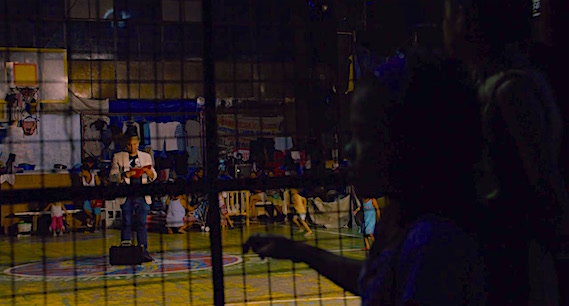
The music and limited dialogue drifts away from us in both perspective and interest.
Ruined Heart
KHAVN, 2014
Cinematography | Christopher Doyle
Violence, tenderness, caresses and kisses are offered but only amid the darkest of moments. In one of the film’s many strange sequences the consuming of a duck egg is shared with a kiss. The duck egg is offered in a gritty and dirty kitchen. The egg itself appears to have gone. As the male begins to chock and spit out the contents of this shared kiss, he receives a caress. The colors and neon lights burn fast, but this is hardly a beautiful world.
As one of the film’s title cards announces, this film is based on a letter to the storm. The town in which the story unfolds appears to be on the brink of recovering from a major natural disaster. Or maybe the town is just waiting for one to come and wash all the dirt and vice away…
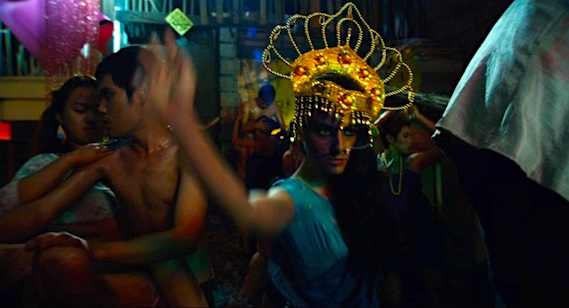
As the street musicians play, the camera moves with chaotic precision to show us the revelers who dance in costume and perform perverse rituals…
Ruined Heart
KHAVN, 2014
Cinematography | Christopher Doyle
This is a world filled with violence, threat, perversity and crime. Stuck in a sort of Carnaval Fever Dream, our Criminal and Whore seem like upstanding citizens. To the film’s credit, they are not. But we do gain a sense that this world is weighing them down. At one point as they make love, The Criminal covers The Whore‘s face with what appears to be a phone book of sorts.
Is he hiding himself from her or her from himself?
As they race toward a mutually shared orgasm, the pages from the book are torn and fall to the floor near the bed. A painting of The Madonna and Child sits watching as the pages of passion fall.

Or maybe The Criminal is hiding his love’s face from The Madonna who sits in the corner of the room…
Ruined Heart
KHAVN, 2014
Cinematography | Christopher Doyle
The actors have very little to no lines to speak. But each performer manages to convey what is needed. Tadanobu Asano really steps up for the film. His on-screen charisma plays a crucial role in advancing the film. He also acts briefly as Christopher Doyle’s camera operator…

Tadanobu Asano’s Criminal guides the camera and perspective to world of cruelty and color…
Ruined Heart
KHAVN, 2014
Cinematography | Christopher Doyle
At arm’s length, we soon see what The Criminal is feeling…

Our perspective is fully dictated by the movement of action to the beat of the drums. There is no escape offered…
Ruined Heart
KHAVN, 2014
Cinematography | Christopher Doyle
The entire production of artists both in front of and behind the camera are in perfect synch with the director, but none are quite as sharply invested as Christopher Doyle’s camera. As our Criminal and Whore attempt to escape the horrific world in which they are trapped — we want them to win, but we already know this score.
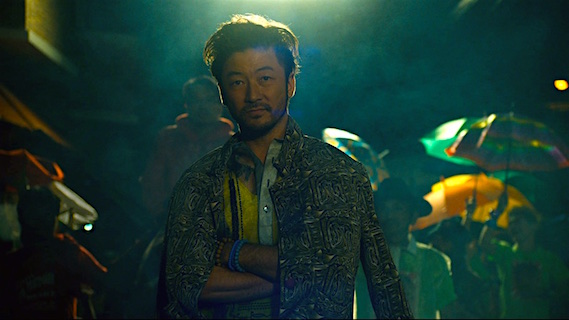
Tadanobu Asano can only pause to hide the pain with a smile or a laugh…
Ruined Heart
KHAVN, 2014
Cinematography | Christopher Doyle
I’ve not seen a film this casually cool since Olivier Assayas’ Irma Vep. Like that 1990’s French film, KHAVN’s Ruined Heart never feels like it is trying to be cool. It quite simply doesn’t care. This oft-told story of a criminal and a whore in love and on the lam is moving forward with or without you. KHAVN has made a movie that is cool simply because it is.
The movie is also alive with energy and new ideas related to storytelling. As KHAVN is a poet, the movie does lend itself to the idea of a Cinematic Tone Poem. However such a tired sort of label feels inappropriate.
In fact, none of the film’s characters manage to live up to their respective identifiers. This is not a real Friend. That is a withering Godfather and this Lover has very little love in her heart.
And the Whore is more a lost goddess and her Criminal is a devoted hero.
Romeo may be bleeding beneath the stone angel, but he and his love find a supernatural and mythic escape. The Criminal and The Whore follow their own beat amongst the playing children and hard-working vendors of KHAVN and Christopher Doyles’ imaginary world of ruined hearts.
Aside from two US film festivals, this movie’s screenings in the West have been largely limited to Europe. This magical little movie was issued via region-restricted Blu-Ray in the UK. A briefly printed region-free Blu was issued, but it would appear to have been edited to secure a PG-13 rating. Ruined Heart is currently streaming in pure form on Fandor in the US. It is worth seeing — but then again so are all films lensed by Christopher Doyle.
See it if you can…
Matty Stanfield, 3.22.2016

